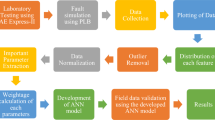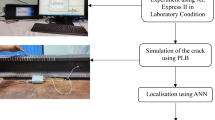Abstract
Railways serve as vital transportation infrastructure worldwide, necessitating continuous monitoring of rail sections’ structural integrity due to diverse climatic conditions and repetitive loading. Conventionally, the large railway network is laid by joining through the weld of a number of small rail sections. Non-Destructive Testing (NDT) methods, while commonly used for inspection, are impractical for continuous monitoring as they require train stoppages. Acoustic Emission (AE) techniques offer a promising solution, enabling real-time monitoring and the detection of faults like crack initiation and propagation. However, the presence of welds in rail sections can interfere with the propagation of AE waves, impacting the monitoring process. This research proposes a deep learning approach combining Artificial Neural Networks (ANN) and Support Vector Machines (SVM) to classify and localize AE signal sources in welded and unwelded rail sections. The algorithm utilizes AE parameters obtained from simulated damage in distinct segments of the rail section (Top Flange, Side Top Flange, Web, and Bottom Flange) for training and testing. The ANN model predicts the distance to the damage source, considering parameters such as Counts, Amplitude, RMS, and Energy. Simultaneously, the SVM algorithm classifies AE signals passing through welded and unwelded portions of the rail, comprehensively assessing the influence of welded joints on health monitoring of the railways. Also, this study reveals that welds can affect the predicted localised distance of damage. It is well understood from existing literature that finding the damage location using the AE technique requires the application of AE sensor data, which are very sensitive. Therefore, this study can help in estimating the correct value of damage location when there is a weld. Additionally, the proposed deep learning approach provides valuable insights into the classification and monitoring of AE signals in rail sections and contributes to the advancement of real-time health monitoring systems for railways.










Similar content being viewed by others
Data Availability
Data may be available on request for research purposes without violating the future scope. For this purpose, researchers can contact the corresponding author.
References
Kostryzhev, A.G., Davis, C.L., Roberts, C.: Detection of crack growth in rail steel using acoustic emission. Ironmak. Steelmak. 40(2), 98–102 (2013). https://doi.org/10.1179/1743281212Y.0000000051
Murav’ev, V.V., Murav’ev, M.V., Bekher, S.A.: A novel technique of AE signal processing for upgrading the accuracy of flaw localization. Russ. J. Nondestruct. Test. 38, 600–610 (2002). https://doi.org/10.1023/A:1022488802820
Murav’ev, V.V., Murav’ev, M.V., Murav’ev, T.V.: The possibilities of acoustic emission testing of rails during exploitation. Russ. J. Nondestruct. Test. 44(1), 33–40 (2008). https://doi.org/10.1134/S106183090801004X
Marais, J.J., Mistry, K.C.: Rail integrity management by means of ultrasonic testing. Fatigue Fract. Eng. Mater. Struct. 26(10), 931–938 (2003). https://doi.org/10.1046/j.1460-2695.2003.00668.x
Bombarda, D., Vitetta, G.M., Ferrante, G.: Rail diagnostics based on ultrasonic guided waves: an overview. Appl. Sci. 11(3), 1071 (2021). https://doi.org/10.3390/app11031071
Kundu, T., Pal, A., Roy, P., Datta, A.K., Topdar, P.: Development of a novel real-time AE source localisation technique using ANN for health monitoring of rail section: an experimental study. Struct. Health Monit. (2023). https://doi.org/10.1177/14759217231171026
Wevers, M.: Listening to the sound of materials: Acoustic emission for the analysis of material behaviour. NDT E Int. 30(2), 99–106 (1997). https://doi.org/10.1016/S0963-8695(96)00051-5
Hao, Q., Zhang, X., Wang, K., Shen, Y., Wang, Y.: A signal-adapted wavelet design method for acoustic emission signals of rail cracks. Appl. Acoust. 139, 251–258 (2018). https://doi.org/10.1016/j.apacoust.2018.04.038
Bruzelius, K., Mba, D.: An initial investigation on the potential applicability of acoustic emission to rail track fault detection. NDT E Int. 37(7), 507–516 (2004). https://doi.org/10.1016/j.ndteint.2004.02.001
Hsu, N.N., Breckenridge, F.R.: Characterization and calibration of acoustic emission sensors. Mater. Eval. 39(1), 60–68 (1981). http://pascal-francis.inist.fr/vibad/index.php?action=getRecordDetail&idt=PASCAL8130189718
Kundu, T., Roy, P., Datta, A.K., Topdar, P.: Health monitoring of indian rail section using AE technique combined with UPVM: an experimental study. J. Struct. Eng. 49(1), 1–11 (2022)
Chen, S.X., Zhou, L., Ni, Y.Q., Liu, X.Z.: An acoustic-homologous transfer learning approach for acoustic emission–based rail condition evaluation. Struct. Health Monit. 20(4), 2161–2181 (2021). https://doi.org/10.1177/1475921720976941
Wang, Y., Gao, T., Liu, D., Sun, H., Miao, B., Qing, X.: Propagation characteristics of ultrasonic weld-guided waves in friction stir welding joint of same material. Ultrasonics 102, 106058 (2020). https://doi.org/10.1016/j.ultras.2019.106058
Yang, S.K., Lee, P.H., Cheng, J.W., Tseng, C.H.: The Study of wave propagation through plates welded joints using guided waves SH0 Mode. 15th Asia pacific conforence non-destructive test. (APCNDT2017 Singap 2017). p. 10 http://www.ndt.net/?id=22210
Jankauskas, A., Mazeika, L.: Ultrasonic guided wave propagation through welded lap joints. Metals 6(12), 315 (2016). https://doi.org/10.3390/met6120315
Crawford, A., Droubi, M.G., Faisal, N.H.: Analysis of acoustic emission propagation in metal-to-metal adhesively bonded joints. J. Nondestruct. Eval. 37, 33 (2018). https://doi.org/10.1007/s10921-018-0488-y
Sayar, H., Azadi, M., Alizadeh, M.: Detection of crack initiation and propagation in aluminum alloy under tensile loading, comparing signals acquired by acoustic emission and vibration sensors. J. Nondestruct. Eval. 38, 100 (2019). https://doi.org/10.1007/s10921-019-0639-9
Ai, L., Soltangharaei, V., Bayat, M., Greer, B., Ziehl, P.: Source localization on large-scale canisters for used nuclear fuel storage using optimal number of acoustic emission sensors. Nucl. Eng. Des. 375, 111097 (2021). https://doi.org/10.1016/j.nucengdes.2021.111097
Clark, R.: Rail flaw detection: overview and needs for future developments. NDT E Int. 37(2), 111–118 (2004). https://doi.org/10.1016/j.ndteint.2003.06.002
Quispitupa, A., Shafiq, B., Just, F., Serrano, D.: Acoustic emission based tensile characteristics of sandwich composites. Compos. Part B: Eng. 35(6–8), 563–571 (2004). https://doi.org/10.1016/j.compositesb.2003.11.012
Kundu, T., Pal, A., Roy, P., Datta, A.K., Topdar, P.: Application of UPV-instrument in health monitoring of Indian rail section using AE technique. In: ASPS Conference Proceedings, vol. 1, No. 5, pp. 1429–1439. (2022). https://doi.org/10.38208/acp.v1.673
Sasikumar, T., Rajendraboopathy, S., Usha, K.M., et al.: Artificial neural network prediction of ultimate strength of unidirectional T-300/914 tensile specimens using acoustic emission response. J. Nondestruct. Eval. 27, 127–133 (2008). https://doi.org/10.1007/s10921-008-0040-6
Rather, A.I., Mirgal, P., Banerjee, S., Laskar, A.: Application of acoustic emission as damage assessment technique for performance evaluation of concrete structures: a review. Pract. Periodical Struct. Des. Constr. 28(3), 03123003 (2023). https://doi.org/10.1061/PPSCFX.SCENG-1256
Pal, A., Kundu, T., Datta, A.K.: Sensor-based smart diagnosis of rail defects using an ann model. Asian J. Civ. Eng. (2023). https://doi.org/10.1007/s42107-023-00690-6
Kalafat, S., Sause, M.G.: Acoustic emission source localization by artificial neural networks. Struct. Health Monit. 14(6), 633–647 (2015). https://doi.org/10.1177/1475921715607408
Kundu, T., Pal, A., Roy, P., Datta, A.K., Topdar, P.: On the application of UPV in health monitoring of Indian rail section using AE technique.https://doi.org/10.58286/27467
Ebrahimkhanlou, A., Salamone, S.: Single-sensor acoustic emission source localization in plate-like structures using deep learning. Aerospace 5(2), 50 (2018). https://doi.org/10.3390/aerospace5020050
Chlada, M., Prevorovsky, Z., Blahacek, M.: Neural network AE source location apart from structure size and material. J. Acoustic Emission 28(1), 99–108 (2010)
Cheng, L., Xin, H., Groves, R.M., Veljkovic, M.: Acoustic emission source location using Lamb wave propagation simulation and artificial neural network for I-shaped steel girder. Constr. Build. Mater. 273, 121706 (2021). https://doi.org/10.1016/j.conbuildmat.2020.121706
Unnorsson, R.: Hit detection and determination in AE bursts. In: Sikorski, Wojciech (ed.) Acoustic emission-research and applications. IntechOpen, London (2013)
Vapnik, V.: SVM method of estimating density, conditional probability, and conditional density. In: 2000 IEEE International Symposium on Circuits and Systems (ISCAS), vol. 2, pp. 749–752. IEEE (2000). https://doi.org/10.1109/ISCAS.2000.856437
Sohaib, M., Islam, M., Kim, J., Jeon, D.C., Kim, J.M.: Leakage detection of a spherical water storage tank in a chemical industry using acoustic emissions. Appl. Sci. 9(1), 196 (2019). https://doi.org/10.3390/app9010196
Samanta, B.I.S.W.A.J.I.T., Al-Balushi, K.R., Al-Araimi, S.A.: Artificial neural networks and support vector machines with genetic algorithm for bearing fault detection. Eng. Appl. Artif. Intell. 16(7–8), 657–665 (2003). https://doi.org/10.1016/j.engappai.2003.09.006
Loutas, T., Eleftheroglou, N., Zarouchas, D.: A data-driven probabilistic framework towards the in-situ prognostics of fatigue life of composites based on acoustic emission data. Compos. Struct. 161, 522–529 (2017). https://doi.org/10.1016/j.compstruct.2016.10.109
li, S.M., Hui, K.H., Hee, L.M., Leong, M.S.: Automated valve fault detection based on acoustic emission parameters and support vector machine. Alexandria Eng. J. 57(1), 491–498 (2018). https://doi.org/10.1016/j.aej.2016.12.010
Chapelle, O., Vapnik, V., Bousquet, O., Mukherjee, S.: Choosing multiple parameters for support vector machines. Mach. Learn. 46, 131–159 (2002). https://doi.org/10.1023/A:1012450327387
Acknowledgements
This study has received support from DST-TSDP, Government of India, and the authors would like to express their gratitude to the Section Engineer, Durgapur, E-RLY, Indian Railway, for providing the rail section utilized in this research.
Funding
The author(s) declare that no funds, grants, or other financial support were received for this article’s research, authorship and/or publication.
Author information
Authors and Affiliations
Contributions
Apurba Pal conducted the experiment and wrote the manuscript. Tamal Kundu reviewed the manuscript. Dr. Aloke Kumar Datta reviewed the manuscript and supervised the experiment.
Corresponding author
Ethics declarations
Conflict of interest
The author(s) declared no potential conflicts of interest with respect to the research, authorship and/or publication of this article.
Ethical Approval
Not Applicable.
Consent of Participate
Not Applicable.
Consent for Publication
All authors consent to the publication of this work.
Additional information
Publisher’s Note
Springer Nature remains neutral with regard to jurisdictional claims in published maps and institutional affiliations.
Rights and permissions
Springer Nature or its licensor (e.g. a society or other partner) holds exclusive rights to this article under a publishing agreement with the author(s) or other rightsholder(s); author self-archiving of the accepted manuscript version of this article is solely governed by the terms of such publishing agreement and applicable law.
About this article
Cite this article
Pal, A., Kundu, T. & Datta, A.K. Assessing the Influence of Welded Joint on Health Monitoring of Rail Sections: An Experimental Study Employing SVM and ANN Models. J Nondestruct Eval 42, 102 (2023). https://doi.org/10.1007/s10921-023-01014-z
Received:
Accepted:
Published:
DOI: https://doi.org/10.1007/s10921-023-01014-z




